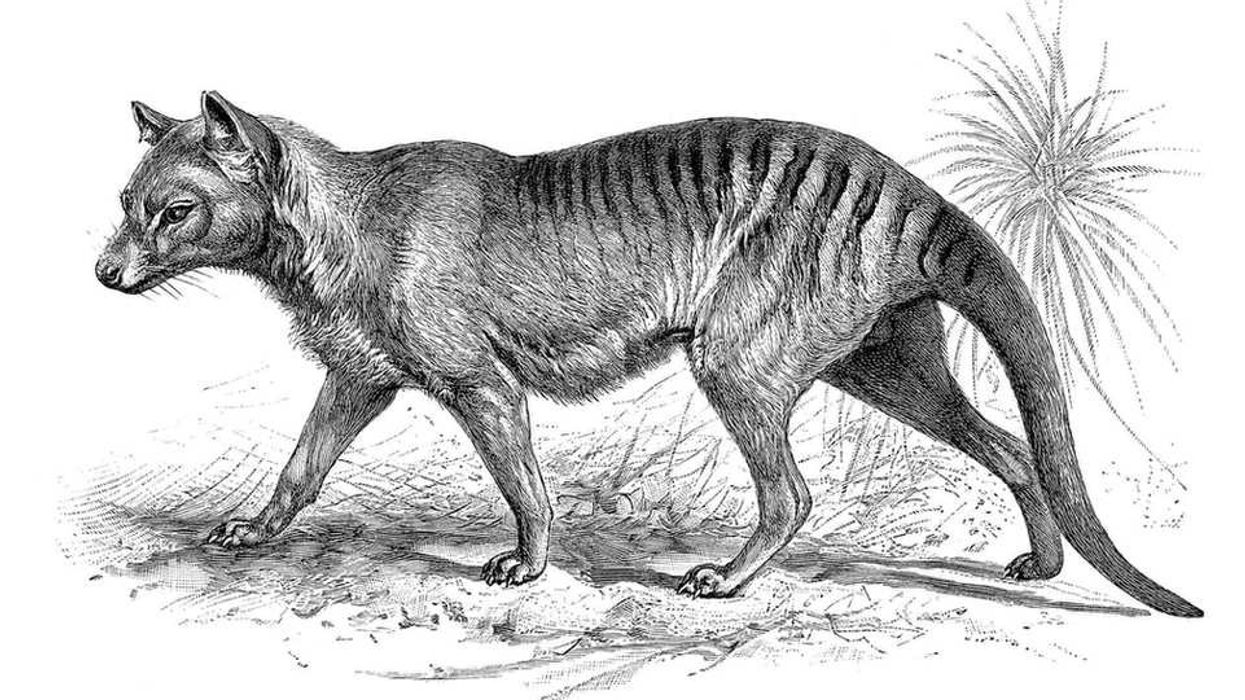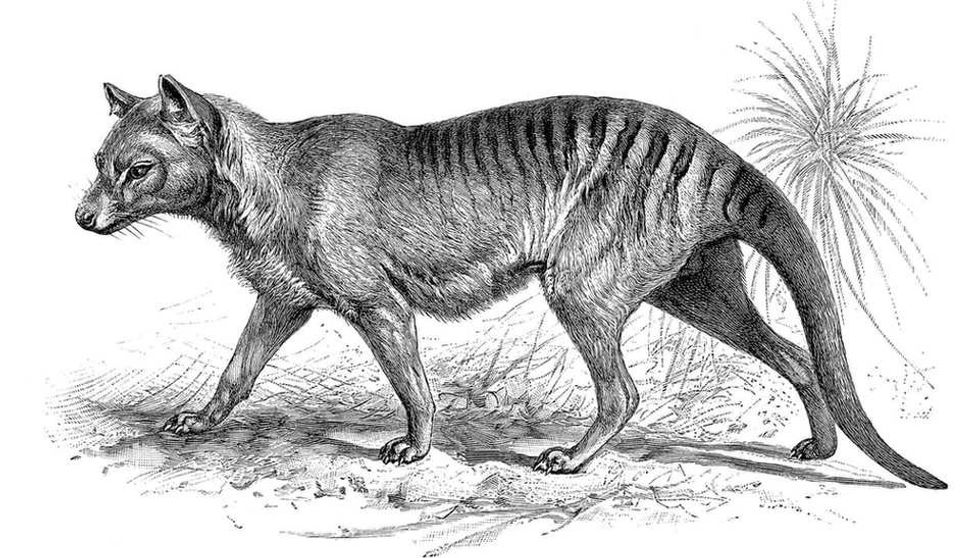Fun Tasmanian Tiger Facts For Kids

Want to read about unique animals that unfortunately have vanished off the face of the earth? Then you'll love reading about the Tasmanian tiger or the Thylacine.
The Tasmanian tigers (Thylacinus cynocephalus) were marsupials and not tigers that were native to the island of Tasmania, Australia. These mammals have also been called a wide variety of names in the aboriginal language such as coorinna, loarinna, kanunnah, laoonana, and others.
Yet, due to excessive hunting and loss of habitat, these animals were wiped out in 1936. Despite many reported sightings over the years, there has been no concrete data to support these sightings.
However, efforts are being made by scientists and biologists all over the world to somehow reintroduce these species again through DNA replication. We hope these efforts will show significant results in the near future.
So, read on for more information on the Tasmanian Tigers. If you want to read more fact files, take a look at the kangaroo and the Italian wolf.
Tasmanian Tiger Interesting Facts
What type of animal is a Tasmanian tiger?
The Tasmanian tiger or the Thylacine (Thylacinus cynocephalus) was a marsupial that went extinct when the last Tasmanian tiger died in 1936 in the Hobart Zoo (also known as the Beaumaris Zoo) in Tasmania, Australia. Many people thought that the Tasmanian tiger was a dog in the beginning but it was actually a marsupial.
What class of animal does a Tasmanian tiger belong to?
The marsupial Tasmanian tiger or Thylacine belonged to the class of Mammalia or mammals. Its family was the Thylacinidae and its genus was the Thylacinus.
How many Tasmanian tigers are there in the world?
Unfortunately, there aren't any Thylacines or Tasmanian tigers left in the world. The marsupial species went extinct. The last known Thylacine died in captivity back in 1936, sending the species into extinction.
Where does a Tasmanian tiger live?
The Tasmanian tiger primarily existed on the Australian island of Tasmania up until its extinction. There is also evidence of these animals living on the mainland of Australia thousands of years ago, according to the National Museum of Australia.
Their remains have even been found on the island of New Guinea and on Kangaroo Island off the state coast of South Australia in Australia. They were known to prefer the woodlands in Tasmania along with the coastal shrublands.
What is a Tasmanian tiger's habitat?
The Thylacine or the Tasmanian Tiger habitat was supposed to be somewhere between the woodlands and the coastal shrublands of Tasmania. It was these coastal shrublands that the British settled in and this may have produced a reduction in the habitat of the Tasmanian tigers.
Until its extinction, little was reported in detail about the habitat of the Thylacine. What is known is that these Tasmanian tigers kept a home range that hovered between 15 square miles and 31 square miles. They were not known to be too territorial.
The Tasmanian tigers were thought to be nocturnal and crepuscular (animals that hunt only during the phase of twilight). They would not really go out during the day and would spend the day in forests and hills looking for shelter in hollowed-out tree trunks and caves.
They would hunt at night and were generally shy animals. Thylacine or the Tasmanian wolf, as they were also called, was aware of the human presence and would avoid humans.
Who do Tasmanian tigers live with?
Thylacines were observed to hunt either alone or in pairs and that too at night according to the Australian Museum. Again not much data and information is available for the Tasmanian wolf, but there are some records that say that there were sightings where Thylacines were seen traveling with groups that were larger than usual family units.
How long does a Tasmanian tiger live?
Normally in the wild, there was evidence that the Thylacine could live anywhere between the ages of five to seven years, however, when they were in captivity, the Tasmanian tiger could live up to nine years.
How do they reproduce?
Although there is evidence that the Tasmanian tiger may have had breeding seasons all throughout the year, experts say they had their peak between the months of May and December. Again due to the Tasmanian's extinct status, there are no comprehensive notes in regards to the mating pattern of the species.
However, being a marsupial animal, the Tasmanian Tiger would carry their young ones in their pouches which opened up to the rear end of their bodies.
The litter of this animal was supposed to contain two to four joeys. There are academic papers that tell us that the gestation period or the pregnancy period of the female Thylacine was around 28 days.
Interestingly, while in captivity, Thylacines were known to reproduce and breed only in one instance- in 1899 in the Melbourne Zoo in Australia.
What is their conservation status?
After the last known Thylacine died in the Hobart Zoo in 1936, remains of some Thylacines were found well into the 1960s. But, Tasmanian tigers were not declared as Extinct species till about 50 years after their extinction due to existing rules in the science community.
However, in the year 1982, the International Union For Conservation Of Nature Red List (IUCN) had declared the Tasmanian tiger or the Thylacine species as Extinct.
The Tasmanian Government also confirmed its extinction by the year 1986, 50 years after the last of this species died. The official Tasmanian tiger extinction date is supposed to be the 6th of September, 1936 when the last Tasmanian tiger, called Benjamin, died.
Tasmanian Tiger Fun Facts
What do Tasmanian tigers look like?

The Tasmanian tigers were dog-headed marsupials. These animals were usually sandy yellow to brown in complexion with around 20 dark stripes that ran across their backs.
It was these dark stripes on the back that gave the Tasmanian tigers the moniker of 'tigers'. On the other hand, their mixture of dog and wolf-like features gave these animals the name Tasmanian wolf.
They had a stiff tail that resembled other closely related animals like the Kangaroo because their tail bones were fused. Their legs were shorter when compared in proportion to their heads.
Their fur had body hair and their ears were erect at a length of 3.1 in. The Tasmanian tigers had five fingers on the forelegs while having four fingers on their hindlegs.
According to observations made by science enthusiasts back then, these animals were thought to have a keen sense of smell. However, recent findings due to the advancement of science show that their sense of smell was underdeveloped and they likely relied on their eyesight and ears to hunt prey.
These animals had pouches to carry their babies, with the opening of the pouch at the rear end of their bodies. Males also had smaller pouches and this was one of the most unique features of the Tasmanian tiger.
How cute are they?
The number of people who have seen a real Tasmanian tiger should be very few with the last Tasmanian Tiger dying in the mid-1930s. However, what we see today are pictures and some preserved bodies, and 3D models of these animals.
Even though science has given us a hint of what these animals might have looked like, it would be very difficult to comment on their cuteness. Yet, simply based on their appearance, many dog-lovers might find the Tasmanian tiger cute.
How do they communicate?
Tasmanian tigers were noticed to give a threat yawn when it was irritated or agitated, along with hissing and growling. It was also known to make repeated guttural barks to communicate with their pack or families.
Along with these noises, they had a long whining howl or cry which would be used perhaps for identifying themselves from a distance. The Tasmanian tiger also had a low-pitched snuffing sound that was again presumably used to communicate with their families.
How big is a Tasmanian tiger?
The Tasmanian tiger's size was known to be around 39 - 51 in with a tail of around 20 - 26 in. In comparison with the Tasmanian devil, another marsupial native to Tasmania, the Thylacine is almost one and half times bigger.
How fast can a Tasmanian tiger run?
Due to short legs and stiff tails, Thylacines were known to have a strange gait. They were also observed to be fast runners. Again, no concrete data exists for us to tell about the exact speed of the Thylacine.
How much does a Tasmanian tiger weigh?
The Thylacine would weigh anywhere between 18 lb to 66 lb, but the average weight of these animals would be between 26 lb to 49 lb. However, sexual dimorphism existed with males being slightly bigger in size than females.
What are their male and female names of the species?
There is no such distinct name for a male and female Thylacine.
What would you call a baby Tasmanian tiger?
Since the Thylacines were marsupial, their babies are usually referred to as joeys.
What do they eat?
The Tasmanian tiger diet was made up of kangaroos, wallabies, wombats, birds, potoroos, possums and Tasmanian emus. These animals were carnivorous in nature. They were also known to prey on sheep and this was one of the main reasons they were hunted in large numbers by the sheep farmers in Tasmania.
(Please include a link to the predator using its name as an anchor text)
Are they dangerous?
They were shy animals who were scared of humans. They were carnivorous in nature but weren't dangerous enough.
Would they make a good pet?
Again, whether they would make a good pet isn't a viable question in this case, as these animals have gone into extinction.
Did you know...
The Tasmanian tiger's mouth had an incredible feature in its jaw which could open up to 80 degrees or more.
The Tasmanian Government declared the Thylacines to be protected species just two months before its extinction. However, Thylacines are a symbol of pride in Tasmania now with the Tasmanian Government using it in its official state emblem.
Due to advancements in science in the 2000s, major work has been done in restoring the thylacine population from the DNA of museum specimens.
Are Tasmanian tigers related to tigers?
No, the Tasmanian Tigers are not related to tigers. The moniker of 'tiger' came from their appearance as dark bands on the yellowish-brown coat resembled that of a tiger.
Why did the Tasmanian tiger go extinct?
One of the main reasons the Tasmanian tiger went extinct was excessive hunting. Perceived wrongfully to be a fierce threat to humans and livestock, Thylacines were hunted in great numbers. Loss of their habitat could have also played a major part in their extinction.
However, since their extinction, headlines such as 'Tasmanian Tiger Still Alive' or 'Tasmanian Tiger Not Extinct' have continuously popped up in the news. Despite reports of multiple Tasmanian tiger sightings, no such authentic proof has been found by any search groups that could change the Tasmanian tiger extinction status.
Here at Kidadl, we have carefully created lots of interesting family-friendly animal facts for everyone to discover! Learn more about some other mammals including the South China tiger and the Malayan tiger.
You can even occupy yourself at home by drawing one of our Tasmanian tiger coloring pages.
We Want Your Photos!
More for You
See All
Bachelor of Arts specializing in Journalism and Mass Communication, Postgraduate Diploma in Sports Management

Moumita DuttaBachelor of Arts specializing in Journalism and Mass Communication, Postgraduate Diploma in Sports Management
A content writer and editor with a passion for sports, Moumita has honed her skills in producing compelling match reports and stories about sporting heroes. She holds a degree in Journalism and Mass Communication from the Indian Institute of Social Welfare and Business Management, Calcutta University, alongside a postgraduate diploma in Sports Management.
Bachelor of Technology specializing in Information Technology

Smriti ChaudharyBachelor of Technology specializing in Information Technology
Smriti, a student data scientist, and coder, is pursuing her Bachelor of Technology at K.J. Somaiya College of Engineering. She has achieved top rankings in the International English Olympiad, National Spelling Bee, and PSAT/SAT English Section. She is experienced in content creation and editing for various academic institutions.
Disclaimer
1) Kidadl is independent and to make our service free to you the reader we are supported by advertising. We hope you love our recommendations for products and services! What we suggest is selected independently by the Kidadl team. If you purchase using the Buy Now button we may earn a small commission. This does not influence our choices. Prices are correct and items are available at the time the article was published but we cannot guarantee that on the time of reading. Please note that Kidadl is a participant in the Amazon Services LLC Associates Program, an affiliate advertising program designed to provide a means for sites to earn advertising fees by advertising and linking to Amazon. We also link to other websites, but are not responsible for their content.
2) At Kidadl, we strive to recommend the very best activities and events. We will always aim to give you accurate information at the date of publication - however, information does change, so it’s important you do your own research, double-check and make the decision that is right for your family. We recognise that not all activities and ideas are appropriate for all children and families or in all circumstances. Our recommended activities are based on age but these are a guide. We recommend that these ideas are used as inspiration, that ideas are undertaken with appropriate adult supervision, and that each adult uses their own discretion and knowledge of their children to consider the safety and suitability. Kidadl cannot accept liability for the execution of these ideas, and parental supervision is advised at all times, as safety is paramount. Anyone using the information provided by Kidadl does so at their own risk and we can not accept liability if things go wrong.
3) Because we are an educational resource, we have quotes and facts about a range of historical and modern figures. We do not endorse the actions of or rhetoric of all the people included in these collections, but we think they are important for growing minds to learn about under the guidance of parents or guardians.







